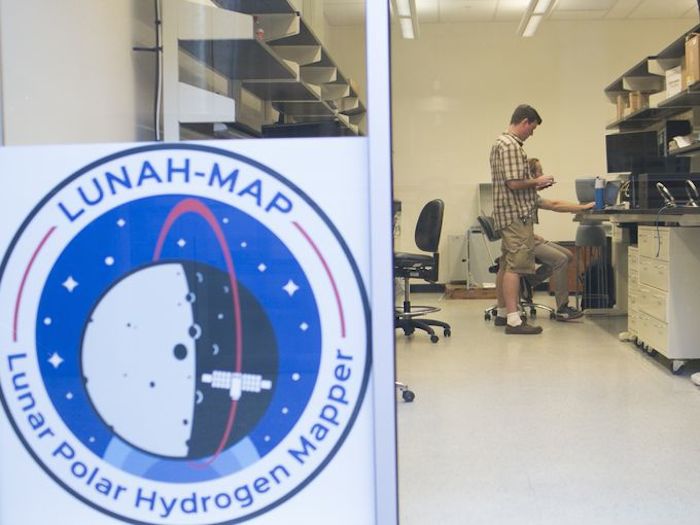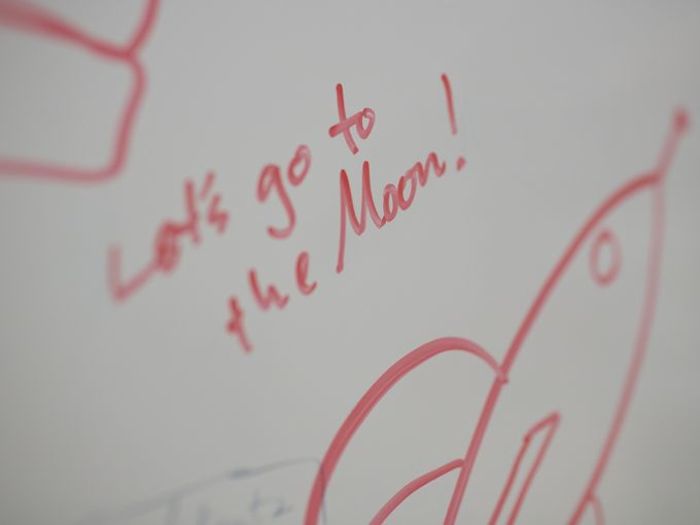.

ASU team working on spacecraft about the size of two loaves of bread that will gather important lunar information
If the size and scope of the Apollo missions are comparable to Imperial Star Destroyers, then the CubeSat being built at Arizona State University is like the probe droid that was sent to Hoth.
A CubeSat is a satellite about the size of two loaves of bread that costs a fraction of traditional NASA technology. The spacecraft are built to gather information on a more focused set of questions because their size limits what they can do.
Craig Hardgrove is the principal investigator of the ASU-based mission, called LunaH-Map because of its goal to map the distribution of hydrogen on the moon.
A little less than a year ago, LunaH-Map was selected by NASA as one of 13 CubeSat missions to be launched in 2018. In May, the team’s lab officially opened up shop on campus.
“I think NASA is hoping for these very tiny spacecraft to play a role in space exploration, even large missions in the future,” Hardgrove said.
Hardgrove and his team recently began to assemble the spacecraft. They've made progress on the communications system that will eventually have to fit into the satellite, he said.
Right now, however, the wires and hardware that litter the tabletops don’t seem like they could ever be condensed to fit inside such a small craft.
The radio and the “brain” of the soon-to-be CubeSat are laid out on two boards. While the pieces are being assembled, they’re referred to by the more apt name FlatSat.
A FlatSat, Hardgrove said, is like “if you took the whole box and spread it out on the table.”
“It’s not meant to simulate the mechanical function or how everything’s going to fit together, but it represents how it’ll talk,” he said.
Communication is key
The radio and the brain do like to talk.
Getting the two systems to communicate was a small but important achievement in these early stages of design, he said.
Getting them to fit, however, will be a whole separate odyssey.
Igor Lazbin, the chief engineer for LunaH-Map, is in charge of packaging together all the components of the CubeSat so it will make it to the moon.
The team has to work within specific weight and volume requirements. So Lazbin said he's constantly in the process of choosing what and what not to put inside the satellite.
"We'd like to include more functionality and do more things, but we are pretty heavily restricted by size and mass," he said.

The meticulous planning will be for nothing, however, if the CubeSat doesn't survive the launch. That's where Rj Amzler, a structural engineer and an undergrad at ASU, comes in.
First, Amzler needs to confirm that everything "fits within the specs of what we're allowed," he said. Then he will help assess the structural integrity of the satellite.
Once the satellite is operational and structurally sound, it will be shot off into space with the 12 other CubeSats in a ring around the rocket.
Different divisions of NASA each chose a couple CubeSat projects to hitch a ride on its new rocket, the Space Launch System. A few satellites are headed to the moon, while others will conduct research on asteroids and space particles.
After launch, there will be several "bus stops" for the CubeSats to leave the rocket and embark on their individual missions, Hardgrove said.
A capsule meant to carry humans will also be perched atop the rocket. But the capsule, called Orion, will be empty for this mission.
“The plan at the moment is ‘Journey to Mars,’ ” Hardgrove said, citing one of NASA's programs.
“Everything that NASA is doing is sort of geared towards getting people into Mars orbit and then eventually to the surface of Mars and back home.”
LunaH-Map has no direct bearing on missions to Mars. But, Hardgrove speculates that many steps down the road both the technology his team has developed for its CubeSat and what they may discover on the moon could help future launches.
Flying low over the moon's south pole
As the CubeSat enters lunar orbit, the team will be able to direct its movements and assess its health from the roof of their building on ASU’s campus.
The goal is a bit tricky, and has never been done before: fly very low over the south pole of the moon. Previous NASA missions were far too expensive to risk crashing to perform the tricky maneuver.
When the satellite is close enough, it will be able to use a specialized instrument called a neutron spectrometer to detect hydrogen. Previous research on the moon shows that the element exists as water-ice in the permanently shadowed craters on the moon.
Tucked in the depths of these craters, the water-ice never sees sunlight and is able to avoid evaporation.
The possibility of similar future NASA missions hinges on the success of LunaH-Map.
If the CubeSat doesn’t crash and if Hardgrove and his team are able to obtain the necessary scientific data, then NASA might continue to use these tiny satellites.
“If we can show that these types of spacecraft can do a very targeted mission and achieve a goal, like in our case a scientific measurement, then in the future we’d want to include those on other human missions,” Hardgrove said.
Thinking years ahead, he also speculated on the implications of the presence of water-ice on the moon. If they are able to find significant concentrations, there may be a possibility to utilize the resource. Scientists may also be able to pinpoint optimal locations to land astronauts on the moon.
NASA has no current plan to send people to the moon. But as the agency works toward sending people to Mars, Hardgrove sees the moon as a logical pit stop and “proving ground” for astronauts.
“The thing about Mars and the moon is that they’re nearly equally as inhospitable to humans,” Hardgrove said. "The moon is a really great place because you can get home very quickly, in two days or so. ... Mars isn’t like that. If something goes wrong, you’re stuck."
The availability of water-ice would make this hypothetical program more possible. Testing new water-based technologies in space would also be easier.
But first, Hardgrove and his team need to discover where the water-ice is with their probelike spacecraft.
"If we find the rebel base," Hardgrove joked, then NASA might send in the big guns.
-

Quelle: azcentral
4311 Views
